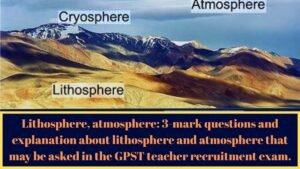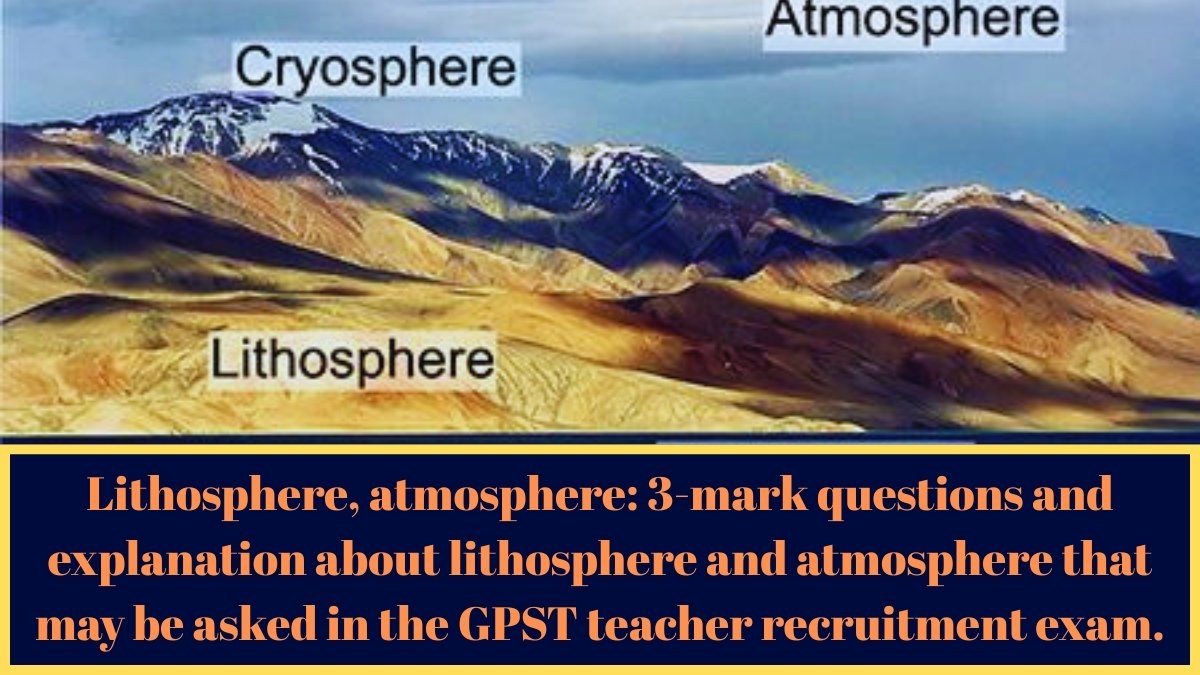Lithosphere, atmosphere: 3-mark questions and explanation about lithosphere and atmosphere that may be asked in the GPST teacher recruitment exam.
1. Which of the following is an example of Plutonic Igneous Rock?
1) Basalt
2) Granite
3) Slate
4) Dolomite
Ans:- 2) Granite
• Platonic rocks:- These are formed from magma that cooled at great depths and contains coarser particles found at depth. Ex: Granite, Gabbro, Diorite, Granodiorite, Tonalite, Mononite etc.
• Hypabyssal rocks:- These are formed when magma flowing upwards cools rapidly and solidifies at a point just below the surface of the earth. For example: dyke.
————————————————————————–
2. Sandstone is metamorphosed to:
1) Shale
2) Slate
3) Quartzite
4) Marble
Ans:- 3) Quartzite
• Metamorphic rocks are formed by the effects of friction and pressure on the original igneous and sedimentary rocks.
• For example, granite → igneous rock, basalt → schist, sandstone → quartzite, shale → state, limestone → marl, coal → graphite, graphite → diamond, etc.
—————————————————————————-
3. Which one of the following is a Sedi-mentary Rock?
1) Granite
2) Charnockite
3) Basalt
4) Arkose
Ans:- 4) Arkose
• Arkose is a igneous rock, specifically a type of sandstone containing at least 25% feldspar. It is usually coarse-grained and usually gray in color.
—————————————————————————–
4. Spot the odd item of the following:
1) Shale
2) Marble
3) Limestone
4) Sandstone
Ans:- 2) Marble
• Shale, sandstone and limestone are important examples of sedimentary rocks;
• Marble is a type of metamorphic rock.
• It is a non-foliated metamorphic rock composed of recrystallized carbonate minerals.
————————————————————————–
5. Spot the odd item in the following :
1) Basalt
2) Ruby
3) Emerald
4) Sapphire
Ans:- 1) Basalt
• Emerald, along with ruby & sapphire, forms the “big three” of colored stones or gems that are metamorphosed in nature. Basalt is an igneous rock.
• Metamorphic Rocks:- Metamorphic rocks are compact, hard, and do not contain fossils. They contain valuable minerals and gemstones. These include gold ore, diamonds, marble, emeralds, rubies, sapphires, etc.
————————————————————————
6. Which of the rock? following is an organic
1) Marble
2) Coal
3) Granite
4) Slate
Ans:- 2) Coal
• Coal is an organic sedimentary rock that is formed mainly from plant remains. Plant remains usually accumulate in moist environments.
• Carbonaceous Rocks:- Plants are composed of carbonaceous materials. The rocks formed by their accumulation are called carbonaceous rocks.
• In ancient times, various types of plants were buried in the earth and transformed into rocks as a result of pressure and temperature. For example: coal, peat, etc. Vegetation turns into coal over a long period of time.
—————————————————————————
7. The majority of Earth’s crust is composed of which rock?
1) Igneous
2) Metamorphic
3) Sedimentary
4) Carbonate
Ans:- 1) Igneous
• The Earth is composed mainly of a large mass of igneous rock.
• The word igneous comes from the Latin word ‘ignis’, which means fire.
• Igneous rocks are primary (first) rocks, formed by the action of volcanoes.
• These are formed by the cooling of lava and magma on Earth or within the mantle.
—————————————————————————
8. Granite, quartzite areas have upstanding look because
1) Mechanically weathered faster
2) these rocks are resistant to all kinds of erosion
3) these rocks are not easily croded
4) not easily worn down
Ans:- 4) not easily worn down
• Granite is high in quartz, a mineral that is very resistant to weathering.
• Similarly, quartzite is harder than steel. Therefore, they do not wear out easily.
—————————————————————————-
9. When Granite rocks get metamorphos -ed, they form
1) Quartzite
2) Gneiss
3) Marble
4) Slate
Ans:- 2) Gneiss
• Neisse is a high-grade metamorphic rock, formed by the metamorphism of granite, an igneous rock.
• Neisses are typically associated with major mountain-building phases. They are composed of layers of sheet-like horizontal structures.
—————————————————————————-
10. Which of the following is not an Igneous Rock?
1) Dolomite
2) Granite
3) Basalt
4) Gabbro
Ans:- 1) Dolomite
• Dolomite: A common sedimentary rock-forming mineral composed of calcium and magnesium carbonate.
————————————————————————–
Lithosphere, atmosphere: 3-mark questions and explanation about lithosphere and atmosphere that may be asked in the GPST teacher recruitment exam.

11. Marble comes under which category of rocks?
1) Sedimentary
2) Igneous
3) Metamorphic
4) None of these
Ans:- 3) Metamorphic
• Marble is a metamorphic rock that forms when limestone is subjected to heat and pressure. It is composed primarily of calcium carbonate (CaCo).
—————————————————————————–
12. Where is the deposits of petroleum found in the following?
1) In igneous rocks
2) In sedimentary rocks
3) In metamorphic rocks
4) No option is correct.
Ans:- 2) In sedimentary rocks
• Sedimentary rocks are mostly composed of sediments or layers. They are usually porous rocks.
• These contain fossils and are made up of the eroded parts of previously existing rocks. They are not crystallized and are found over a wide area on Earth.
• These include minerals such as coal, petroleum, natural gas, sandstone, shale, and limestone.
• It usually contains other minerals such as clay minerals, micas, quartz, pyrite, iron oxides, and graphite.
• Under metamorphic conditions, the calcium carbonate in limestone recrystallizes to form a rock that is a mass of interlocking calcite crystals.
—————————————————————————–
13. What percentage of the total area of lithosphere has the expansion of mountains?
1) around 26-27%
2) around 30-31%
3) around 33-34%
4) around 41-42%
Ans:- 1) around 26-27%
• About 26-27% of the total area of the lithosphere is covered by the extension of mountains.
• Lithosphere:- This is the rigid outer layer of the Earth, consisting of the crust and upper mantle. The lithosphere is divided into tectonic plates.
• The upper part of the lithosphere that chemically reacts with the atmosphere, hydrosphere, and biosphere through the process of soil formation is called the pedosphere.
——————————————————————————-
14. A Scientific study of rocks that deals with their composition, texture and structure; their occurrence and distribution; and their origin in relation to physicochemical conditions is called
1) Geologty
2) Lithology
3) Geomorphology
4) Petrology
Ans:- 4) Petrology
• Petrology refers to the scientific study of rocks and the conditions that influence their formation. Petrology is a branch of geology that focuses on chemical analysis in various fields such as petrography and mineralogy.
• This applies to all three major types of rocks; igneous, metamorphic, and sedimentary.
—————————————————————————-
15. The scientific discipline concerned with the description of rock successions and their interpretation in terms of a general time scale is called:
1) Paleontology
2) Stratigraphy
3) Mineralogy
4) Geodesy
Ans:- 2) Stratigraphy
• The study of stratified rocks is called stratigraphy.
• It is a branch of geology that deals with the interrelationship, interpretation, and description of stratified sediments and rocks found on or below the Earth’s surface.
• Stratigraphy is a science that deals primarily with the study of layered sedimentary rocks (called strata).
—————————————————————————–
16. __________is a metamorphic rock form characterized by banding caused by segregation of different types of rock, typically light and dark silicates.
1) Gneiss
2) Quartzite
3) Slate
4) Marble
Ans:- 1) Gneiss
• Transformation is called ‘Metamorphis’ in English. It comes from the Greek language and means ‘change of form’.
• Igneous and sedimentary rocks are metamorphosed as a result of pressure and temperature as they are buried in the Earth. For example: granite becomes igneous rock, jade becomes shale, sandstone becomes quartzite, shale becomes schist, coal becomes graphite, and limestone becomes marble.
————————————————————————–
17. What is the solid crust or the hard top layer of the earth called?
1) Mantle
2) Lithosphere
3) Biosphere
4) Hydrosphere
Ans:- 2) Lithosphere
• The outer layer of the earth is called the ‘Lithosphere’ or Crust. It constitutes only 5% of the total mass of the earth. In this zone, seismic waves travel at a speed of 5.6 km per second. Its size varies in different parts of the earth. It extends only to a depth of about 10 to 60 km. In the oceans, it is found only up to 10 km.
• On continents, it is found at depths of about 40 to 60 km.
• It consists of three types of rocks: igneous, metamorphic, and sedimentary.
————————————————————————–
18. The final boundary between the Earth and the outer space is called________
1) magnetosphere
2) ionosphere
3) mesopause
4) magnetopause
Ans:- 4) magnetopause
• Magnetosphere:- The region above the Earth in which charged particles are influenced by the Earth’s magnetic field. The exosphere is now considered part of the magnetosphere.
• Note:- The zone beyond the troposphere is called the exosphere. It extends up to 1000 km. The Earth’s gravitational force is the lowest in this zone. The magnetic field is found above this zone.
• The flare of light seen in the outer reaches of the polar region is called the polar light.
• The Northern Lights (Aurora Borealis) are seen at the North Pole and the Southern Lights (Aurora Australis) are seen near the South Pole.
—————————————————————————-
19. Which of the following controls the wind speed?
(1) Pressure gradient
(2) Rotation of the earth
(3) Insolation
(4) None of the option is correct
Ans:-(1) Pressure gradient
• Wind is nothing more than the movement of air molecules from one place to another due to the pressure drop, Coriolis force, and surface friction.
• Wind speed is controlled by the strength of the pressure gradient (the difference in pressure between two locations). A strong pressure gradient increases wind speed.
————————————————————————–
20. Where does most of the weather phenomena take place?
1) Ionosphere
2) Troposphere
3) Stratosphere
4) Tropopause
Ans:- 2) Troposphere
• The transition zone is the ‘mixing zone’. The word ‘tropos’ comes from the Greek language and means ‘mixing’ or ‘turbulence’.
• This is the lowest layer of the atmosphere. Living things exist here.
• All changes in climate occur in this zone. Therefore, it is called the transition or change zone and is also known as the productive zone of climate.
• Temperature, pressure, winds, clouds, and other characteristic features such as lightning, thunder, rainbows, and rain are commonly found in this zone.
————————————————————————





